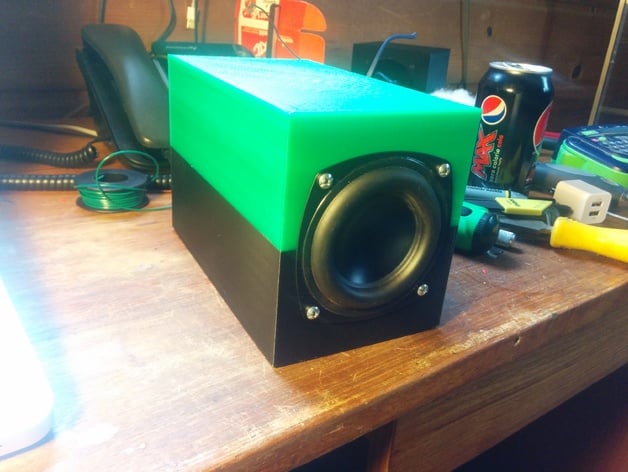
SpeakerGen
thingiverse
Check out this demo-video for this project at:http://nothinglabs.blogspot.com/2014/09/speakergen-parametric-3d-printed.html Build your own speaker enclosures using 3D printing technology! This OpenSCAD / Customizer script allows you to: Design a box of any desired volume, ratio, and wall thickness. Calculate optimal sealed box size for any driver using Thiele / Small parameters (Qts, Vas and Fs). Include cutouts for speaker terminals and screw holes. Create a bass port of any dimensions. With inexpensive full-range drivers available on the market - you can easily 3D print speakers that sound great! Important: If running locally - make sure to install HarlanDMii's Write.scad library: http://www.thingiverse.com/thing:16193 To build a set of speaker enclosures, follow these steps: Required parts: Speaker drivers Fasteners Polyfill from fabric store (highly recommended) Enclosure Design in 30 seconds --- Speakers Gen provides an intuitive tool that automatically calculates an optimized sealed box for your driver's parameters. You can use "Thiele/Small" parameters to help determine what kind of box will work well for your speakers. Sealed Boxes Sealed boxes are the simplest design option - primarily one variable: size. They are very flexible, with speaker drivers sounding decent in multiple enclosures sizes (e.g., 1.0 and 1.25 sealed liters). An important parameter describing a speaker / driver system is "Q." A box's Q helps dictate its F3 value, or bass frequency. Common Q values for sealed speakers fall within the range of 0.7 to 1.4. The Q of an enclosure will always be larger than that of the driver. Increasing box size lowers its Q and vice versa. Accepting a smaller Q (0.7) provides optimal low-end response but results in larger enclosures. Smaller enclosures, however, offer reduced bass output but fewer risks associated with poor design. To obtain a certain Q value and desired F3 frequency - SpeakerGen applies simple math, just like other closed box calculators:http://www.mh-audio.nl/ClosedBoxCalculator.asp Ported Boxes Ported boxes use tuned ports to enhance low-end response (aka bass reflex). Designing these enclosures is slightly more finicky due to increased potential for resonance. Using tuned ports and optimizing design elements helps reduce unwanted sound - ensuring a superior listening experience. These boxes usually result in lower F3 frequencies compared to sealed boxes, typically under 50hz. Print Tips My speaker cabinet weighs approximately 1 lb. Calculating a predicted frequency of around 60 hz when using the AuraSound NS3-193-8A speaker - it is an attractive choice due to its small footprint. Tuning bass to achieve low hz was necessary with such a compact design. Recommended settings: Infill - 20% (suitable for enclosures up to 1.75 l)
With this file you will be able to print SpeakerGen with your 3D printer. Click on the button and save the file on your computer to work, edit or customize your design. You can also find more 3D designs for printers on SpeakerGen.
